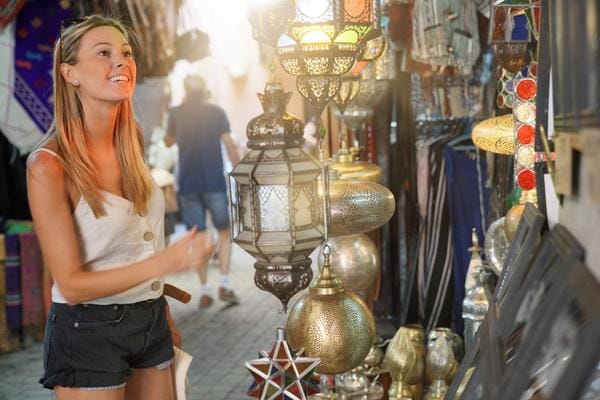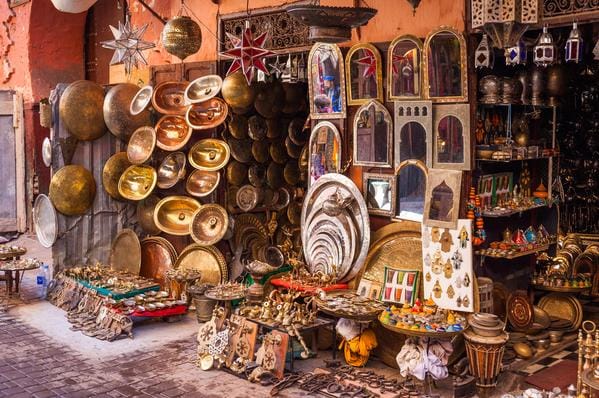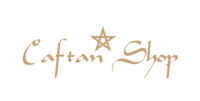Marrakech is famous for its cultural and historical sites in the former medina and modern attractions in the colonial district of Gueliz. For more information do not care for consulting our article on The Morocco.
The great lively markets are another popular attraction in Marrakech, attracting visitors from around the world to buy a variety of items and enjoy the atmosphere. If many Moroccan cities have souks, none is comparable to that of Marrakech.
In this article we will see the following points:
- The story of the souks of Marrakech
- Find your way through the souks
- What can be purchased
- Scams and tricks
- The different souks
BRIEF HISTORY OF THE SOUKS OF MARRAKECH
The central location of Marrakech has earned him to be chosen as the capital of Almoravids. After fortifying the city with high walls and solid doors in massive doors, the city has become an important business center.
Located along the Sahara trade route, convoys passed by to go to the Saharan regions or come back. As its popularity increased, traders started coming to Marrakech from various regions of the country, eager to buy and sell various items.
There were small daily markets throughout the medina for residents, and greater weekly and monthly souks strategically installed throughout the area.
The famous Djemaa El Fna Square was once the theater of the largest public market, sellers also settling in the surrounding streets, which look like a labyrinth. Many souks took their names of the products sold or the day of the week where they took place in the past.

Find your way in the souks
The souks of Marrakech, like the medina in general, have narrow streets that look like a labyrinth. It is easy to be disoriented and streets and stalls can quickly look alike.
Make sure you have a plan as well as the address and telephone number of your home in case you could not return through your own.
Remember that the medina is surrounded by a wall; By walking straight in any direction, you should get to the outside wall. It will be enough to jump into a taxi or walk along the wall to find your destination.
Look for landmarks to help you orient yourself; Many people use the imposing minaret of the Koutoubia mosque.
Avoid asking for your way to random people because they could offer you to take you and then require compensation. Ask for traders (who can not easily leave their stalls), police officers or families with children.
The souks can be a little overwhelming at first, with the myriad of images, sounds and smells, not to mention the crowd of people and donkeys that trot in narrow streets.
If time is limited or if you are not very sure of exploring the souks for yourself, use a local guide can be the perfect way to enjoy the souks and discover things you could have missed by yourself.

What can we buy in the souks of Marrakech?
If you can buy almost everything you can imagine in vast and varied souks of Marrakech, some items are particularly widespread or make excellent memories and gifts.
Of course, traditional clothes like Djellaba, caftan and leather babouches are available in abundance, in different sizes and colors.
Cashmere scarves are versatile and add a little spice to any outfit. They are also perfect for covering yourself in the sun and to cover your hair in conservative places.
Ordinary clothing, wool caps, Fez hats and other clothes and accessories are sold in narrow streets.
The leather items are numerous, including watch bracelets, belts, bags and portfolios. The jewels are another common article to buy in the souks. Silver bracelets are particularly popular, with many models to tempt you.
A large number of carpets and carpets are on sale in the souks of Marrakech, and with more than 40 Berber groups contributing to the local carpet production, there is necessarily one that attracts your attention.

How about sitting on something? The poufs are widespread and they are very compact.
Metal lanterns are other interesting additions for any home, and you may be tempted by ceramic vases with detailed reasons. There are many smaller decorative items if space is a determining factor, such as candlesticks, mirrors and lamp zippers.
If you fell in love with Moroccan cuisine and want to reproduce the flavors at home, a pot in Tajine could be a great article to buy in the souks. They are available in different sizes and with attractive colored patterns. Remember, however, that they can be heavy to carry.
You will also find in the touks of the dishes, tea services, teapots, colorful glasses, pans and hammered metal stoves, as well as other kitchen and meal items.
Naturally, the production of Moroccan dishes requires some ingredients. Buy olive jars and bottles of olive oil, dried fruits and nuts, as well as a range of spices.
As for the trinkets, you will be spoiled for choice: keychains, fridge magnets, pencils and small decorative objects, you can bring kitsch home.
Although ARGAN oil is not produced in Marrakech, the sellers offer an assortment of products made from this highly sought-after oil.
You will find faces for the face, body lotions, soaps, lip balms, hair products, etc. Other cosmetics and toiletries are also on sale in the souks of Marrakech.
Ghassoul clay is another local product not to be missed; It plays an important role in the hammams. Toys, novelties, musical instruments, works of art, textiles and medicinal remedies are just some of the other products you will find on the souk stalls of Marrakech.
How to haggle and negotiate the best prices?
The prices you pay in the souks finally depend on your skills. For starters, you must have a general idea of what you want to buy and approximate costs.
It is always useful to get an impartial advice on price ranges, for example from a person who works in your hotel or Riad. Visit multiple stalls to compare prices.
Note: Do not enter in-depth negotiations at this point, simply compare the proposed prices. Do not start negotiating only when you intend to make a purchase.
Let the seller state the first prize and offer a much lower price. The goal is to try to achieve a price that is advantageous for both parties. Remember that the seller will not sell the article at a price that is not good for him.
Similarly, keep in mind that people ultimately try to earn a living and do not allow you to arrange for relatively low sums. Keep in mind the exchange rate and the amount you would be willing to pay for the article.

Scams and current tricks in the souks of Marrakech
False guides:
Several fake guides operate in the souks, offering tourists to help them find the best shops and negotiate lower prices. You may get a price below the requested price, but this includes a commission for the guide ... who will probably also want to get a tip after your shopping experience.
Do not explore an approved guide and keep careful when some institutions are more recommended than others.
False products:
As in most major markets in the world, many fake items are on sale in the souks of Marrakech, and many pass for authentic. Make sure to know how to distinguish an authentic product from a fake and, if in doubt, leave the product behind you. Similarly, if an offer is too beautiful to be true, be cautious!
Tattoos in Henne:
Beware of henna tattoolers in Marrakech, especially around Djemma el Fna and neighboring souks. A common scam consists of a woman taking her hand and starts creating a simple motive without asking it.
The combination of curiosity, the friendliness of the artist or crook and surprise makes people often finish their drawing. If you say while you do not want a larger or more complete design, they will usually try to extract a payment for the small drawing.
A payment that is often disproportionate and, in the end, for something you have not asked and you do not want! They can be pretty insistent, so avoid the situation and move away from henna artists who are approaching you.
Always check the money
Always check the money you replace and also check your currency. As in most crowded places, pay attention to pickpockets and bagbag thieves.
DIFFERENT SOUKS OF MARRAKECH
Marrakech has protected his rich commercial heritage, with many fascinating souks that are still found today in the old town. Although it can be difficult to discern where a souk ends and where another starts, with overflowing stalls along small streets, there are several distinct souks that sell different products. Here are some of the souks of the city:
Souk Naal
This souk was dedicated to the sale of handmade leather babouches for the shoe industry. Today, the market continues to sell traditional Moroccan babouches, called Balgra, and many craftsmen are in the nearby streets.
Walk al attract
This market was known for the sale of silver and copper items, with pots, dishes, jugs, trays, tea services, decorative items, etc. The market continues to settle every day except Friday, dazzling people with complex and well-made metal works.
The March of Qashashbia
The Qashashbia market was created by the manufacturers of Djellaba, the traditional coat-shaped clothing worn by many Moroccans. Tailors still work hard to produce quality clothes and the souk now offers a range of other traditional textiles.
Takmouti walk
The Takmouti market became known for its exquisite jewels and precious metals. Named after Takmut's goldsmiths, it's an excellent Marrakech souk for anyone who wants to browse and buy beautiful handmade jewelry.
Souk al haddadin
Souk Al Haddadin was once a hive of activity before the religious holiday of Eid Al-Adha, with many people who pressing to buy knives and cutlery. Today, blacksmiths manufacture essential household items throughout the year. The craftsmen also specialize in beautiful iron decorations. These pretty pieces are also exported to different countries of the world.
Souk El Kemakhin
This market is specialized in leather stool. The nearby tanneries leather is used to produce good quality equestrian equipment. You will also find here a wide choice of lamps.
Souk Al Sabbaghain
The specialty of this market is the dyeing of the wires used in the manufacture of traditional woven carpets. Observe qualified craftsmen who dye wool in a variety of colors.
Souk Ahayek
Al Hayek is a dress that is worn by women. It is made of wool. This souk takes its name from this garment and some of the shops here are still specialized in knitted clothes.

Souk Al Jeld
Souk Al Jeld was once a renowned market for people seeking to repair leather items. It is still active in trade in tinted leather products, and is a leading supplier of leather slippers and other leather goods, including bags, belts, watch bracelets, etc.
Walking of the old Rahba
This market was once devoted to the sale of cereals. Today you can find all kinds of medicinal herbs and spices, snails and other culinary and medicines.
Souk al najjarin
The souk al najjarin is known for its wooden craftsmen. You can browse a wide range of exquisite wooden objects, young and old. The details of the desires are very impressive, and you can observe the craftsmen cut, saw, chop and thoroughly lobed the pieces of wood to get the details exactly as they wish.
Souk Lghzel
This souk was once an important place for the purchase and sale of wool thread. Today, however, it is mainly filled with ladies selling a variety of new clothes and opportunities.
Souk Fekharin
The Souk Fekharin is an ideal place to get pottery. Various items are available, including vases, dishes, jugs and decorative objects. There are many shapes, styles and colors to attract your attention.








Leave a comment